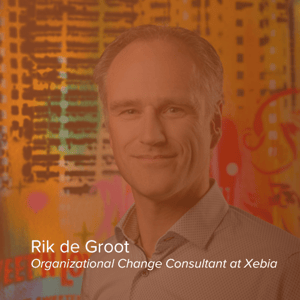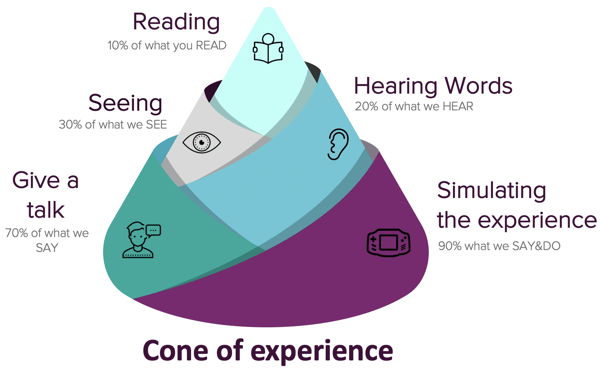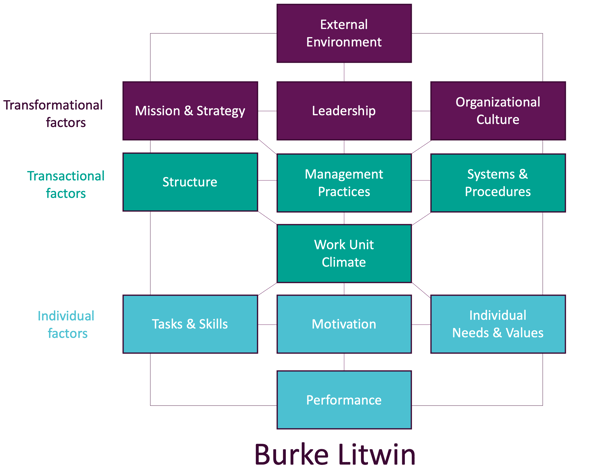Experimenting by using business simulations
Shifting to a new type of organization requires more than just a change of the operating model. It also involves a change in beliefs and thinking. Combined, they represent paradigm shifts that change the rules of the game. Business simulations are the best way to experience these shifts by experimenting with them.
Authors of this article are Marianne Pot and Rik de Groot.

Shifting Paradigms
The world around us changes fast. Organizations must be able to adapt and stay relevant to their employees and the market to keep up. A paradigm change is usually unavoidable.
According to the Kuhn cycle [1], these paradigm shifts happen after everyone reali
zes that the current model of how we organize can no longer serve as a reliable guide. In the next stage, the model breaks down, and attempts to fix it fail. In the revolution stage, serious candidates emerge from the crisis, such as Agile, Holacracy, etc. In the paradigm change stage, the new paradigm is taught to newcomers and those in already. When the new paradigm becomes the generally accepted way, the new paradigm becomes the new normal.
So, what is the best way to start teaching and guiding teams and organizations through this paradigm? In our experience, the best way to do this is through a business simulation.
Simulating the future state
New paradigms are usually hard to understand if you have never experienced the new paradigm. For instance, to sail on you own on a sailboat or fly an airbus 380, just reading the instruction guide doesn’t usually help much when starting to fly or sail.
One of the most effective ways to learn is to simulate reality [2]. A business simulation is a powerful tool for organizational learning and development. Business simulations are interactive learning experiences that allow participants to truly engage in the material. Furthermore, it is a safe environment where you can learn and experience situations that usually occur only once in a while. Besides this, it offers to freeze-frame and allows for discussion of what happened.
Dynamics during the simulation
The future organization paradigm will be different every time. However, the primary drivers that need to be considered are usually the same as described in the Burke-Litwin Change model [3]. Burke and Litwin claim that the external environment is an essential change driver. External factors trigger internal transformational factors such as leadership, strategy and organizational culture. The primary variables predict and explain the total behavior output of an organization. During the simulation, you can see the interaction between these variables and how they affect change. The four dimensions: the external environment, transformational factors, transactional factors, individual factors and performance, will be covered.

During the simulation, depending on the ask or organizational challenge, the accent could be on any one of the 12 elements:
- External Environment: Factors as markets, legislation, competition, and the economy.
- Mission and Strategy: The reason for existing and how the organization will go about achieving its mission.
- Leadership: Attitudes and behavior of senior colleagues and how the organization perceives these behaviors as a whole. Individuals in leadership positions are responsible for developing a vision and for motivating the rest of the organization to achieve it.
- Organizational Culture: “The way we do things around here.” It considers the beliefs, behaviors, values, and conventions that prevail in an organization.
- Organizational Structure: The way the organization is structured and impacts relationships, responsibilities and ways of working.
- Systems and policies: Policies, procedures, and mechanisms that have been set up to help and support employees, such as ICT resources, workplaces, meeting rooms, etc.
- Management Practices: Behavior and activities of managers. How well do managers adhere to the strategy, and how do they deal with the available resources? How are their dealings with employees? Lead by example!
- Work Climate: Employees' perception of the work environment. How do they experience cooperation? How comfortable do they feel? And do people think they are sufficiently rewarded for their efforts?
- Task requirement and individual skills/abilities: Are all the right skills in place? Can they be developed? Or do they need to be brought in from outside?
- Individual Values and Needs: Team dynamic. In a perfect world, we would recruit the exact fit for our teams regarding personal style, abilities, and skills mix. However, in reality, it is not always possible.
- Motivation: What drives employees in combination with individual and organizational goals?
- Individual and Overall Performance: Productivity, quality requirements, efficiency, accountability, and customer satisfaction. The balance between work and private life.
Note that the simulation can only cover a part of these elements. However, it usually reveals issues and problems or aspects of it. After the simulation, the organization can zoom in on these problems during a root cause analysis.
Simulations accelerate learning processes.
A simulation that mimics the same practice makes it clear much quicker where things can go wrong and what can be done about it. "You get feedback that you would otherwise get much later, or not at all.”
In our experience, simulation-based learning is just like the real thing. The dynamic environment of business simulations allows participants to put theory into practice in a risk-free environment. Through this kind of experimentation, participants can put ideas to the test, see what works, and become innovative in their solutions to problems.
Communicate more openly
Many advantages of game simulations lie in the area of communication: “With a game, you create a common language with which the details of a project or change can be discussed.” The traditional boundaries between departments are bridged by working together in the simulation. And because hierarchical relations can be set aside during the game, it is possible to communicate more openly. Business simulations increase mutual trust in the organization. And for change processes to succeed, trust is an essential factor.
The result is more mutual coordination and more ownership. A simulation that mimics the same practice makes it clear much quicker where things can go wrong and what can be done about it. "You get feedback that you would otherwise get much later, or not at all."
Conclusion
The use of simulation is an uncommon thing to do in organizational change. However, in other complex environments like flying an airplane, it has proven its value and is a common practice. In our experience, simulations are also useful in organizational change. During the simulations we have done, we saw many benefits.
Some of the benefits:
- Practice complex situations without risk.
- Best way to learn new skills.
- Best way of learning that lasts better.
- It reveals bottlenecks.
- Give insights for management and employees.
- Opens the road for future improvements.
- It’s fun to have the same experience and working together.
- Common language.
In summary, simulations are the way to do a transformation. Start with simulating to get everyone on the same level and experience how the new paradigm feels and looks.
References:
[1] Kuhn Cycle, Wiki - The_Structure_of_Scientific_Revolutions, (1962)
[2] Cone of experience; WIki Edgar_Dale, (1969)
[3] Burke–Litwin model of organizational performance and change, (1992)
Do you want to know more about this topic?
Register for the acceleration simulation And register for the Webinar Future of Work - Simulate the paradigm shift, Friday November 6th, 2020 10 a.m.
And register for the Webinar Future of Work - Simulate the paradigm shift, Friday November 6th, 2020 10 a.m.




